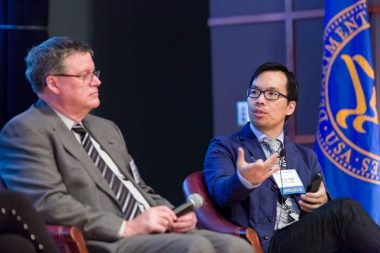RaDaR Serves as Starting Point for Creating Rare Disease Registry

Patient registries are a hot topic of rare disease research and many organizations are taking advantage of this resource by signing up their patient communities and connecting with researchers.
Eric Sid, MD, program officer for the Office of Rare Diseases Research (ORDR), said it is difficult to estimate how many registries exist in the U.S. In Europe, however, the online portal Orphanet has counted a total 0f 812 regional, national, European, and international registries. The number is at least that high or higher for the U.S., Sid told Bionews, publisher of this website.
For advocates who are untrained in data science, setting up a registry can seem overwhelming. Legal issues and technological capabilities are among the numerous topics that must be navigated.
ORDR created the Rare Diseases Registry Program — dubbed RaDaR — in 2019 to provide a starting point for those facing such a daunting task. RaDaR since has evolved to become an educational resource hub that helps rare disease advocates develop their own patient registries.
At the center of RaDaR is its consistently updated website, which has been designed with ease-of-use in mind. Sections in the site focus on setting up and managing a registry, and each subsection features a resource page and links that add more information. A glossary helps define often-unfamiliar terms such as “adeno-associated virus,” “biomarker,” and “factorial assignment.”

Eric Sid, MD, speaks with Forbes Denny Porter, MD, PhD, clinical director and senior investigator at NIH’s Eunice Kennedy Shriver National Institute of Child Health and Human Development, during a panel session on Rare Disease Day in 2019. (Photo courtesy of Daniel Soñé Photography)
“You can think of it as almost like an encyclopedia, but structured to walk [someone] through the process of developing a registry,” said Sid, who, in addition to his role at ORDR, is program lead for RaDaR and the National Center for Advancing Translational Sciences (NCATS) Toolkit for Patient-Focused Therapy Development.
Scientists also can use RaDaR as a way to connect and work with a patient community to develop a registry that might help answer a research question for that rare disease.
RaDaR was developed from what was learned in the Global Rare Diseases Patient Data Repository (GRDR) program, created in 2010, which sought to make patient groups’ datasets more interoperable, Sid said.
GRDR would have accomplished the task of bridging rare disease registries by, for example, converting paper registries into a type of machine-readable format. It would have taken a considerable amount of time and money to have done it for all rare diseases.
“It wasn’t something that we had the resources within our office to kind of scale out,” Sid said. “If we had to do that, you know, like 20 registries per year, you could think of it like we’ll never get anywhere close to 7,000,” he said, referring to the approximate number of recognized rare diseases.
The GRDR program completed two, two-year, proof-of-concept periods to develop new rare disease registries and map existing ones before being replaced by RaDaR.
Sid, who has a master’s in health administration and has experience coordinating resources for affordable housing, joined NCATS in 2017, around the time it launched the Toolkit for Patient-Focused Therapy Development and GRDR was evolving into RaDaR.
The toolkit website, according to Sid, was not user-friendly. While it initially housed a collection of online resources on therapy development, it was difficult for patient or advocacy group leaders to find information about the process itself. So, the online portal was redesigned, offering educational materials with a listing of available tools.
That design approach was transferred to RaDaR when Sid and his colleagues were developing its website. The idea is to make the process more efficient for patients and advocates. Instead of having ORDR employees repeatedly answer the same type of question, it made more sense to provide answers at a single location in an easily-digestible web format.
“Essentially what RaDaR and the toolkit try to do is they try to act as a framework for us to provide similar general responses that people are looking for,” Sid said. “Rather than having to look through my inbox for where I sent this before, it has it all there.”
While RaDaR does have a great deal of information, Sid is careful to ensure it isn’t overwhelming. Specific questions that aren’t answered via the website are directed to him or another staff member.
RaDaR is updated frequently with new resources and educational information. According to the NIH description of the program, “RaDaR will serve as a living website.”
Sid doesn’t want RaDaR to replicate what’s out there. Each section of the website has a resources page, pointing to information provided by other organizations, such as the World Federation of Hemophilia, EURORDIS Rare Diseases Europe, Global Genes, and The Milken Institute, a nonpartisan think tank.
Building a registry can help connect patients with the same rare condition from across the world and help researchers understand the natural history of a rare disease. With this kind of information, Sid said, scientists can learn and ask more questions about the data.
“If you don’t measure it, you don’t know,” he said.
A registry also can improve the efficiency of enrolling patients in a clinical trial and charting their progress with experimental treatments. Clinical trials usually have eligibility criteria for including or excluding a patient, such as age, weight, and testing results. Equipped with a registry, nonprofit organizations can select the patients who best fit those criteria and ask if they would be interested in enrolling. It’s a win-win for researchers and patient groups.
When developing a registry, Sid said, an organization must be transparent with how the data is being used and build trust among the community it intends to serve.
“It’s … important to make sure that patients have their voices represented in how these registries are developed [and] how they’re managed over time, but also that it’s being used to help support the goals of that patient community as a whole,” Sid said.






